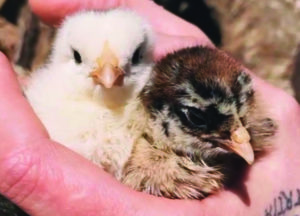Though our “Cogsie,” a.k.a. Rooster Cogburn, has been proudly prancing and mounting, he and our hens have not yet succeeded in producing any new chicks. I know they’ll get there, but with Easter around the corner I could not resist the urge to fill our home now with the peep-peeping of newly hatched chicks.
I had been thinking anyway of diversifying our fairly common flock by adding some fancy feather-footed breeds. Brahmas and Cochins are two known for their calm dispositions. They’re big birds with the added bonus of being more likely to lay during the cold months. Having a few would be a practical thing to do.
With that excuse in mind, I pulled into NewFarm in Orleans last week, where fluffy, days-old chicks were on sale for under $10 apiece. Last year, due to pandemic-inspired chick shortages, we ordered from away. Normally, though, I’d recommend buying from local stores such as NewFarm or Agway, because they ensure their chicks are healthy and strong before they go to new homes. Plus, they can help you stock up on all the supplies and advice you need to get started.

While brooding and hatching chicks can be somewhat complicated for novice backyard farmers, raising baby chicks is easy. Most chicks are sold vaccinated for the two most ubiquitous diseases, coccidiosis, a parasitic infection, and Marek’s disease, caused by a virus. You’ll leave the farm store with the right food and a drinker to ensure their water stays clean. They’ll thrive if you occasionally add electrolytes, for hydration, and probiotics, for digestion, to their water.
These littles are surprisingly hardy as long as they have a constant heat source for their first four to six weeks outside the egg.
If you’re adding new chicks to an existing flock, don’t expect your older hens to rise to the occasion and nurture your adopted brood. Maybe, if you happen to have an exceptionally broody mother hen — one who stubbornly sits on eggs you’re trying to collect — there’s a chance she might take an interest. But more likely, she won’t.
Your chicks need warmth they can count on. A lot of people use heat lamps, but even better is a radiant heat contraption — ours is an Electric Mama Hen. This “Mama” is a platform that’s warm on the underside, and at just the right height for newborn chicks to squat comfortably below deck. We place heater and babies in a large, repurposed aquarium next to a window on our kitchen table. That way the chicks can get some natural light, and we can watch the always-amusing early weeks show.
There’s no denying that, like human babies, chicks do a lot of eating and pooping. Count on cleaning out their nursery at least once a day, preferably twice. And you need to know about something called pasty butt, which is when poop pastes up to the chick’s vent, so waste cannot be eliminated. It happens mainly in the first 10 days, when chicks are not yet producing a full complement of digestive enzymes. The condition is easily remedied, but if it goes untended, it can kill your chicks.
Gently wash any affected chick’s downy backside under lukewarm running water, massaging the area with your finger until the plug loosens. Make sure not to disturb the chick’s umbilical cord. As a farmer, you cannot be squeamish about these aspects of care. Just wash your hands thoroughly after the task — in fact, wash your hands each time you handle a chick.
After about four weeks, weather permitting, you can move the chicks outside to their own, well-insulated mini-coop and enclosure. Like adult chickens, chicks are omnivores and want to eat grasses, tiny worms, and insects once they reach that age.
Chicks need to grow to be pullets, fully feathered and 6 to 12 weeks old, before they can join your flock. And because older chickens may bully them, I’ll save the subject of how to introduce pullets to an existing flock for another story.
But this chick-rearing process is not just an Easter whim. It is something to plan on doing at least every two to three years, as most hens lay eggs only for about that long. If you’re like us, you’ll look forward to the joys of chick season and will end up adopting a few each year.



